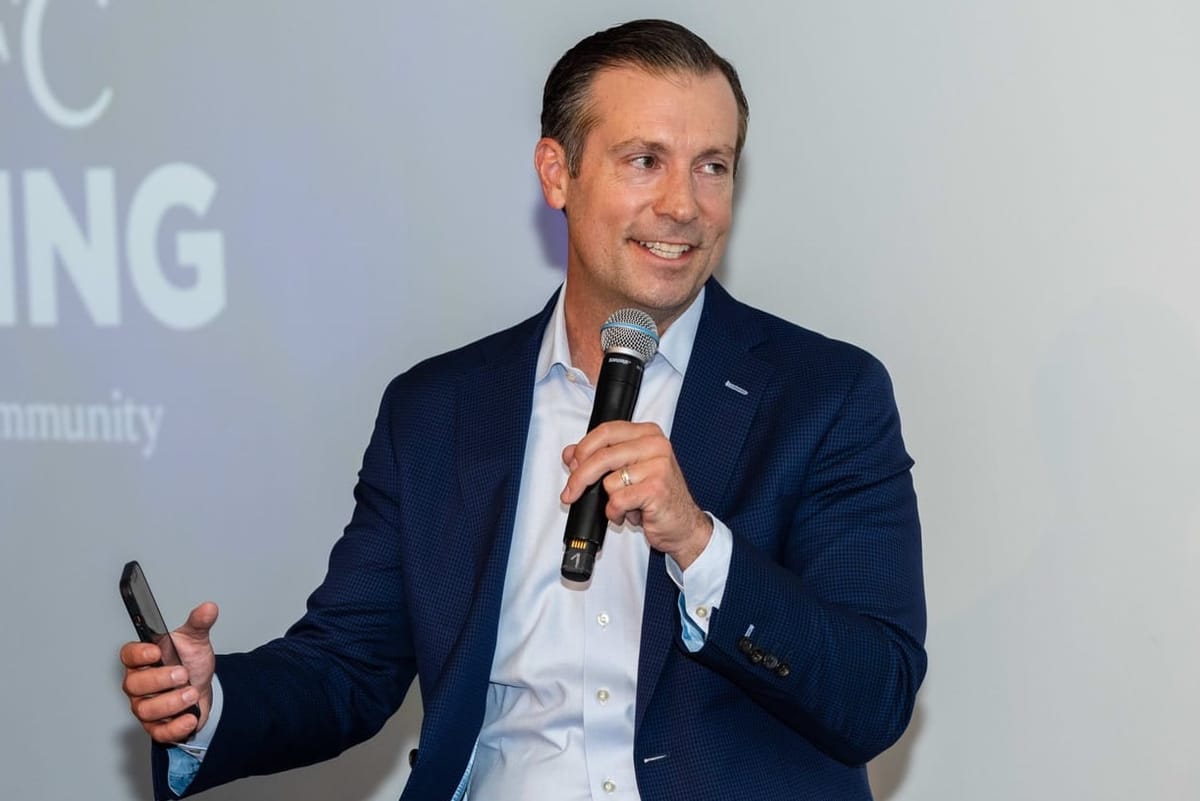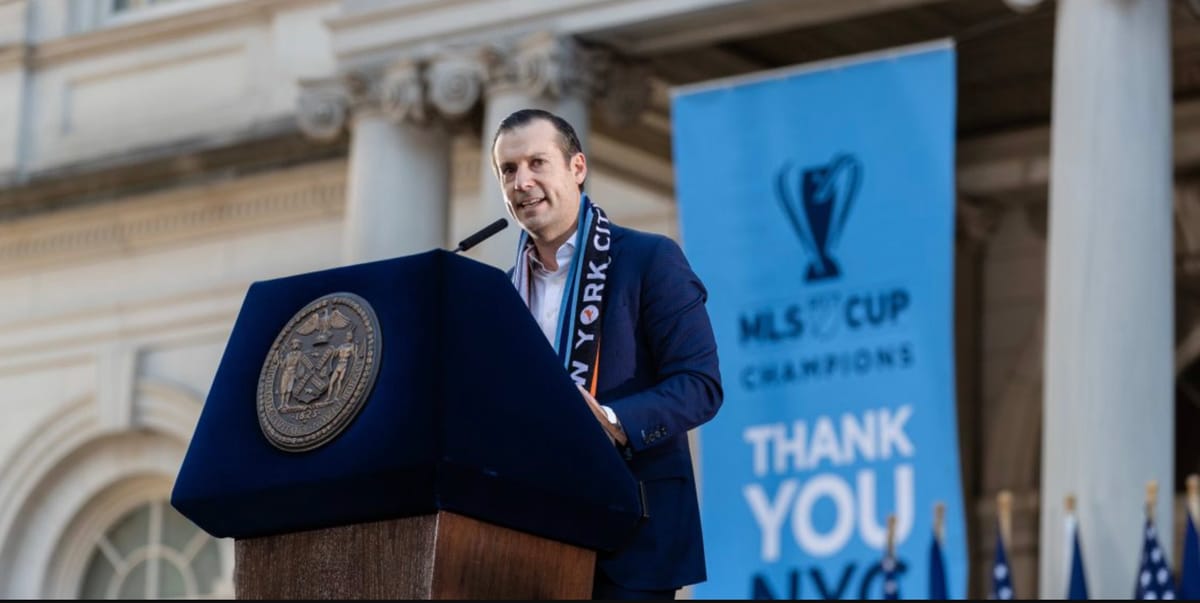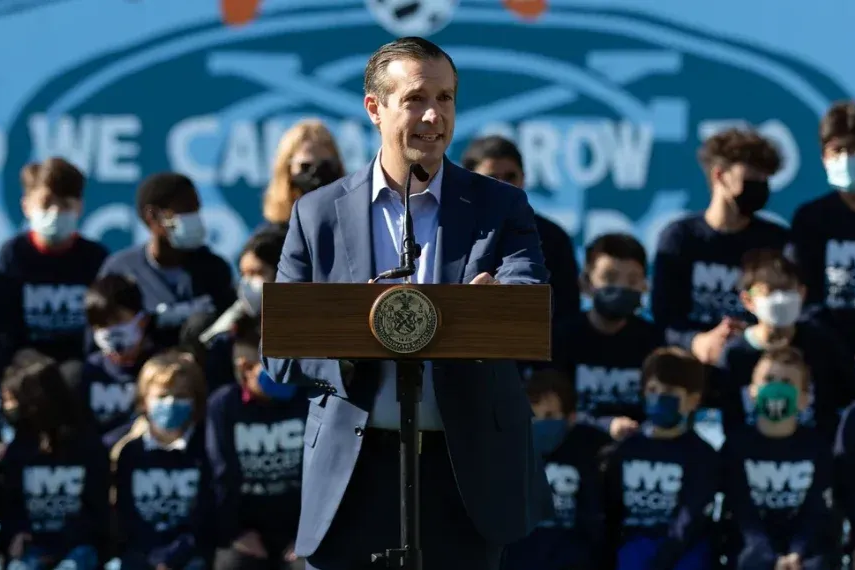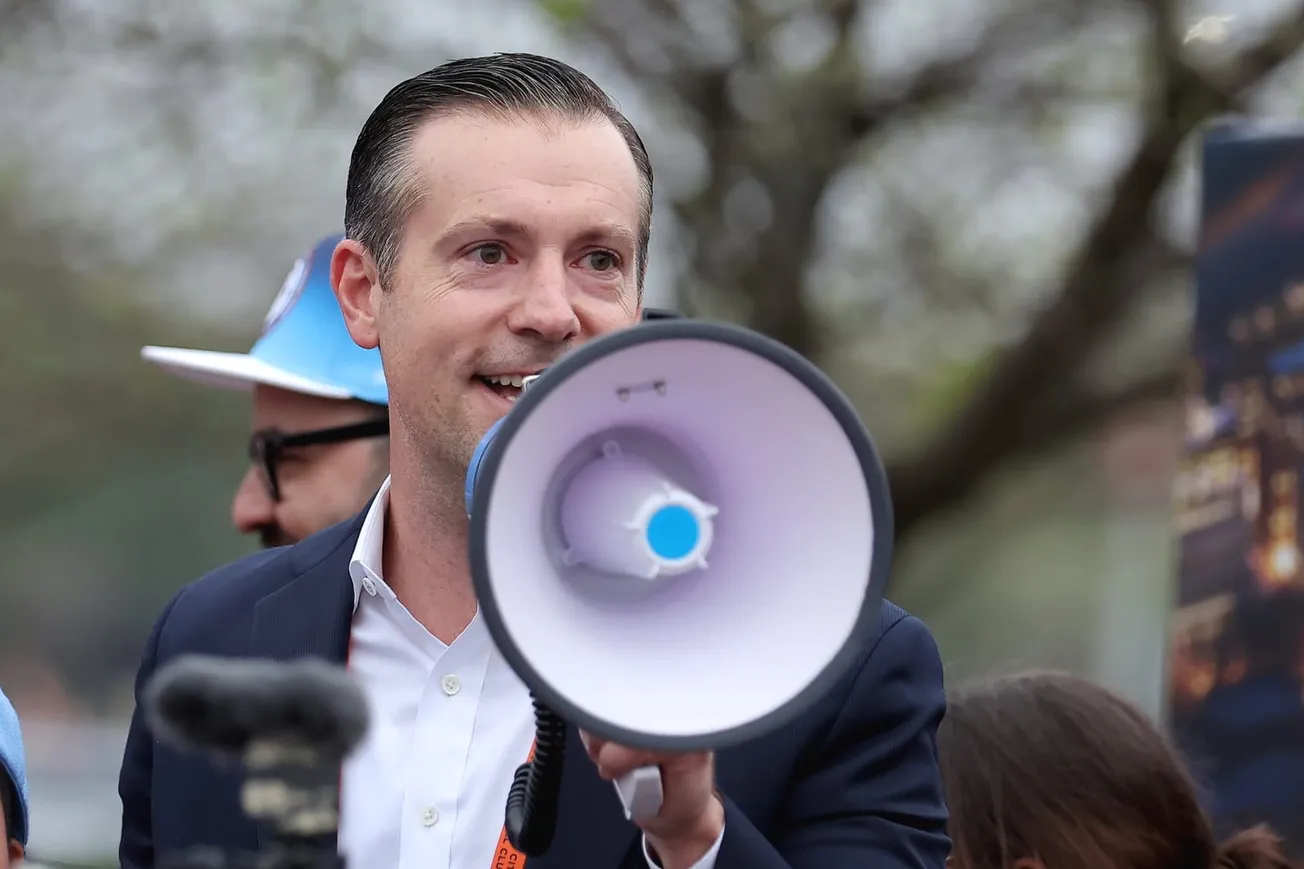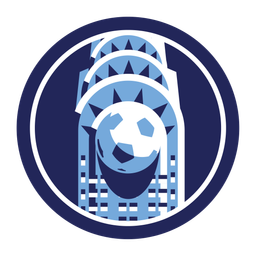Last month, the media sat down with New York City FC President and CEO Brad Sims for a roundtable discussion at the club's headquarters in Midtown Manhattan. It was the second time this season that Sims was made available to media, and no topic was off the table.
Sims joined the club in January 2019, and oversaw two of the club's greatest triumphs: Winning MLS Cup in 2021 and finalizing stadium approval earlier this year. This discussion with Sims addressed a wide range of subjects, from his role as President and CEO, to building a full-scale mockup of parts of the stadium at NYCFC headquarters, to the role of media in the growth of MLS, to where the league might expand next, to what kind of roster New York City are building. The conversation lasted for more than one hour.
Part 1, "6 Million fans can't be wrong," looks mostly at issues directly addressing New York City FC. Part 2, "Playing the long game," looks at league-wide topics, and will run tomorrow.
Note: The statements below were edited for length and clarity.
What does the President and CEO do?
I'm ultimately responsible for everything that happens at the organization.
Obviously, I don't have a background in scouting or player development or anything like that, but I spend a good amount of my time working with Dave Lee and the team. Not talking about players, it's more, "How can we work to provide the resources and the tools that they need to be successful in their area?"
That's the way I look at my job as CEO. Whether that's with Dave Lee, or that's with Jen O'Sullivan, our COO, or with Andy Widdowson, our CFO, or Sam Cooke [Vice President, Communications], or you can go on down the line. The way I view my role is working with every group we have in the organization.
I think that I need to be close to the product and be involved in, and be knowledgeable enough, to be included in the decision-making process for major decisions in any area of the business. Whether that's infrastructure, whether that's sales, whether it's marketing, or whether it's sporting.
That's the beauty, I guess, of working in sports. Remember, for me, it's different every week, you know? Last week1 it was sporting-heavy because I went to LA and Nashville, and so I was with the team for the whole week, and I'm still calling in and doing various other meetings and calls. But it was more spending time with Dave, spending time with Nick and the coaching staff, and the support staff, and the players.
This week has tons of events at night. We're doing a big sponsored dinner tonight. It's really neat. We talk about specific topics and issues and tonight's topic is around marketing to the Hispanic consumer in New York City. But it's not necessarily through the lens of New York City FC. It's through the lens of the healthcare industry, and the consumer packaged goods industry, and so on and so forth. I have a World Cup 2026 organizing committee event tomorrow night.
Obviously, you know, my highlight of the week is spending time with you guys here today.
Stadium-related business is every day, every week.
So I'm split, I would say, between the stadium and current business. And the stadium, I would say, is split into construction, budget, design-related, and then sales- and marketing-related. That's probably the lion's share.
Willets Point: Relationships deliver the right project
The reason I think that everything went so smoothly from the time we announced it all the way to here so far is because of all the work that was done leading up to that and especially getting consensus and near-unanimous kind of support for it politically and on a community level.
I don't know if anyone saw the clips from the City Council meeting when they voted for it. You see other City Council members in their congratulatory messages to Council Member Moya.
It was moving. His words were emotional when he spoke before the vote. But you could see the consensus, and that isn’t something that just happens overnight. You've got to have the right people and the right voice.
You know, relationships deliver the right project. If he was delivering a crappy project for Queens, I don't think that it would have gone so swimmingly. He was able to deliver what is going to be a transformative, amazing project for Queens.
But also the folks at Community Board Seven were amazing to work with on the front end. That was the first step. If things were rocky then, that rockiness could have carried over to the subsequent steps.
I think it was having the proverbial ducks in a row, which is a lot of work, and took a lot of time. Marty Edelman from our side led that component. He's masterful in his relationships with the City. The way he does business, I think, was conducive to helping us get the outcome that we had. And I think he'll continue to help us be able to stay on budget, and stay on time.
It's not easy. You know, budget stuff. It's, Hey, we got to try and refine this or refine that. We're a little bit over here. If we go from tile A to tile B, we could save $182,000 and no one will ever know the difference.
It's that level of detail that we're in right now. How do we stay on budget? We're talking about the types of chairs. Like, this chair is $240, and that chair is $180, and we need 2,000 of them.
We all get in a room, and we all sit in them and move around, and we're like, pretty comfortable. This is good. You know, 60 bucks times 2,000 chairs. That's real money.
Unfortunately, that took a long time to get to the right place, and then also get the right group. We had to find this perfect storm of having a champion for the product, and a project in the district that they represent. We had to have a Mayor that was willing to really get behind it. You know, [we had] a previous site, and we had a regime change, and it killed a previous project. So, you have to have community board members who want it in their community.
And you have to have dialogue that leads to understanding what's important for that community and how can we deliver that, whether that's green space, whether that's not having events simultaneously with your next-door neighbor because it will cause too much traffic, whether that's having an elementary school, whether it's a police precinct, community centers. What's important, and trying to figure out a solution to make those things happen so that you can get consensus, and in our case, get overwhelming support.
How to pay for the Stadium
It's not like, “Hey, get the stadium approved,” and then three years later, “Poof!” it's going be there. It’s getting this thing built, getting it built on time, and selling it.
Essentially, this is 100% percent a privately-financed building, but now the pressure for me and my staff is, “Okay, how do we generate revenue to pay for it?” As you know, very few professional sports stadiums and arenas these days are fully, privately financed. Very, very few.
Now, how do we pay for it? That's sponsorship, and it's going to be premium seating. Those are the two major revenue streams. Obviously, we have general seating as well. But in terms of where do the dollars come from, it's sponsorship and premium seating.
We've been working for well over a year to tee that up. We'll have agency partners on both sides of those to assist us as well, companies that have had tons of success in doing projects like this. But generally, that's where all the focus and pressure is going to be.
I think a two-and-a-half, three-year sales runway is helpful. We need that kind of time to generate the revenue that we need to be able to pay for the building. We're going to have a lot of debt service, and we have to come through on that. How do we pay for this thing is an everyday conversation I have. I have meetings every single day. And I probably will every single day for the next two-and-a-half years.
Something that's standard practice for new buildings and new stadiums and arenas and things like that: We'll be building a preview center for the stadium.
We're super excited about it. We've actually taken an additional full floor in this building. We demoed the entire floor and are under construction right now. It's 12,000 square feet, and probably half of it will be office space for the stadium sales team and stadium operations team.
And in the middle of it will be a 6,000 or 6,500-square-foot, preview center, which essentially will share the vision of the stadium. That's where we'll be bringing potential corporate partners and suite holders, and premium seat holders to show them the dream.
That's going to be a process that will probably start at the end of the summer, give or take Labor Day-ish. And then we'll have that in use for the next two-plus years, and hopefully, it will be full of current fans, future fans, and businesses that are excited about this project.
Like I said, it’s now standard practice. When I was in Nashville, I went down and took the tour of the facility for the new Titans stadium. They call it Titans House. Very impressive. Very, very impressive. And so, I'm really excited about ours as well.
Once we've broken ground, you'll see more overt marketing about the stadium. You know, put your deposit down for a seat at the new stadium, and try to build up this waiting list.
But the good news: We have about two-and-a-half years to sell it. We think over that period of time, and with all the positive momentum that our club has, and that soccer has in this marketplace, we will get to the point where a sufficient demand will exceed the supply of what we have to offer.
"We promised a brick"
Our plan right now is fans will be getting a brick. We promised a brick. Founding Members, I should say, will be getting a brick.
We’ve been in close consultation with our supporters’ groups throughout this whole process in trying to figure out what makes sense. The most traditional kind of brick is on the ground. Citi Field has bricks on the ground and they take quite a beating and also kind of tough to take a selfie unless you’re lying down on the dirty ground on your back which people like to do. They get weathered, people are stepping on them. It’s not great. In consultation with them, we said, “We can either do it traditional, on the ground, or we can build a wall next to a facade of the stadium somewhere, and it was very overwhelming in favor to do a wall instead.
Is the wall going to be a brick wall, or is it going to be something else? Essentially, how are we going to memorialize those names? We’re still working through what that looks like.
But the idea is we want it to be somewhere, ideally situated somewhat close to the supporters’ entrance because of the connotation of the connectivity with supporters. We want it to be big enough and at a height that is close enough that people can take pictures with them. There’s a lot of thought that’s gone into it, but we haven’t actually finalized the exact application. We’ve looked at a lot of different memorial sites, in terms of, are they indented, or are engraved, are they etched in, or pulled out, or indented in, what does that look like? We’re still working through all that.
Ultimately, we’re really excited and the supporters' groups have been super helpful in driving what the end result of the location and what it looks and feels like.
The Rebrand: Six million soccer fans in New York City
Generally, when you are marketing a product or a service, and a company goes through some kind of rebrand, you're not expecting it to have immediate dividends.
I think it's more of a long game. Ideally for us, it's positioning us for the future in a way that would make us most attractive to our target demographics. Using Roosevelt Purple, and Neon Yellow, and all these other things probably aren't attractive to the demographic that follows baseball on certain legacy media formats.
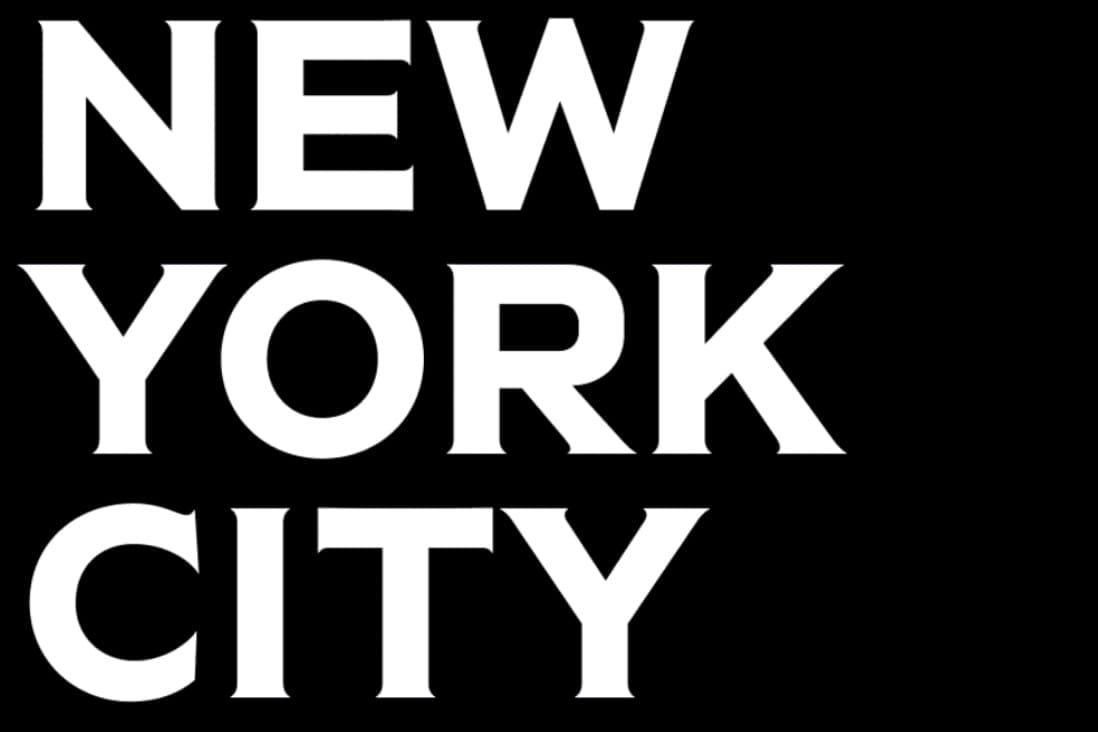
We’re presenting the brand in a way that we believe will be more interesting and will drive to our target demographic, and will ultimately drive fandom.
In case you weren't aware, soccer is already very big and it's only getting bigger, and telling that story and, in some ways, making it safe for people who are already interested in soccer to be like, yes, like I wanna follow New York City FC.
And I say “safe.” I use that word specifically because our data suggests we know that there are over six million people in our direct area that self-identify as soccer followers or soccer fans. This is through our market research data, and Nielsen data, and other data services that we work with and subscribe to.
If you just take people who already self-identify as soccer fans or followers in the New York City area, and you make them a US city, they'd be the third-biggest city in the US.
To me, that says we have an incredible opportunity. We have people in this marketplace, a lot of them, that are interested in soccer. Are they interested in soccer because they love Messi? Or they love Ronaldo? Or they love Barcelona, or they love Man City, or Man U, or Liverpool, or et cetera, et cetera?
Then how do they get to know about us, and then ultimately love us? That's obviously a long game. That does not just happen overnight.
But we do feel that the timing of this going in, doing a rebrand in early 2024 – there's some evolution to the rebrand, more steps to come soon – to get us through this cycle of the rebrand will position us for when soccer is being elevated in the marketplace and across the country as the primary water-cooler talk, like it is right now.
I had a meeting at 53rd and Park earlier today.2 I walked there, it was hot, and I walked back, and every restaurant that had a TV had Euros on them. And I'd be willing to bet that those places will also have a Copa [América] game tonight, as well. Everywhere you go in the city is soccer, all day, all night, right now.
To me, that's great for us. Some people will say, well, how does MLS and New York City FC cut through that? This, for us, is a long game. It's not like, “Hey, wait, guys, we have a game on Friday night. Like, let's figure out how to take advantage of it for this Friday.”
To me, it's more about how people are talking about soccer, people are watching soccer. It's the thing that everyone's talking about. It's the thing that they're watching. It's the thing they're doing right now.
We want to be positioned as, "If you love soccer, or if you like soccer, or if you're interested in soccer, and the reason you're interested is because you like watching Messi when he plays on TV, or you like watching Ronaldo when he plays on TV, or you like watching Barcelona, or whoever your team is that you follow in Europe, or your team that you follow in Brazil, or the team that you follow in Argentina, that if you live in New York, you can come watch soccer – high-caliber, high-level, professional soccer – live, and get that live experience in your backyard."
You can still be a fan of the teams that you were following before. We're not asking anyone to drop them and only be a fan of New York City FC. That’s the beauty of soccer. That's not the case in basketball, or baseball you know. Soccer is the only sport where it's commonplace to support multiple teams in multiple countries.
The roots and the diversity that we have in the city – people from Mexico, people from South America, people that have European roots, that have the teams that they follow, that their parents follow, and their grandparents follow – is awesome. Keep following them.
But you're not watching them play live in person because you live in New York, and they’re in Argentina, or Brazil, or Italy, or Spain. But you can hop on the 7 train and come see us next Wednesday. Or you can hop on the BD and come see us play on Friday night and get that experience.
And oh, by the way, in 2027 you'll be able to get an authentic soccer experience in a purpose-built soccer-specific stadium that is the first one ever in the city, and you can be a part of that. You can be a part of history. You can be there from the beginning.
With everything that's happening in this sport over the next three years, if we position our brand in an attractive way to those people, that is going to really elevate the club. That's the thought, that's the hope, that's the plan.
I give a lot of credit to our ownership group and our stakeholders for being able to take a long view on all this. I've worked in the sports industry my whole career, and I've seen ownership groups that only care about the current season or the next month. We have the good fortune with our group that bought into this club 10 years ago, in this country, because they knew that soccer in the US is in it for the long haul.
Legacy vs new media
Generally, my thoughts on this are that if I were running one of these media organizations or any company I guess, generally you are trying to cater your product to your target consumer. And I would say legacy mainstream media, their target consumer for the most part is not our target consumer.
For the most part, their target consumer generally skews older. It may be less diverse, depending on the outlet, depending on the market. Newspapers have gotten digital and moved to a different direction, but network TV or AM radio stations typically have a different demographic following than the people who follow you guys, and the people that we, as a football club, proactively market to.
That doesn't mean that there aren't people in their fifties and sixties that like soccer, or that come to our games or support the club because obviously there are. But, you know, baseball and soccer have an extremely different demographic.
I think soccer is like 42-ish. You're getting younger. And our target demographic is even younger for us as a club in terms of where we're proactively trying to market. You can't be everything to everyone, and it's impossible in this city to market in a cost-effective, efficient manner to lots of different demographics, so you have to be very targeted. For us, those targeted demographics are different from most of the mainstream media.
Also, think about who the decision-makers are in those places. I'm making generalizations, and I don't want to just be full broad-brush with all this stuff. But I've been in these kinds of roles in these kinds of industries for a long time, for decades, and soccer wasn't a thing. Unless their readership or their viewership is demanding more soccer coverage, there's no reason for them to change their ways.
In many cases, I believe that their readership or viewership is not the demographic that is as interested in soccer. The people who are interested in soccer find other means to get their news and their information. We see where it's such a fractured landscape now from a media standpoint.
And, you know, I've come full circle. Would we like coverage from major broadcast networks? Sure, of course, of course we would, because if someone wants to give us coverage, we'd gladly take it.
Is that going to really move the needle with our business? I'm not really sure that it would. Because the people that go to those outlets are probably not the people that we're targeting for our product right now. I think you guys provide a ton of value, and the people that are really interested consume what you guys put out, and that works.
1 This interview was conducted in late June, 2024.
2 The 2024 Euros and 2024 Copa America were in group stage play at the time of this interview.
